MNG92100 Assignment: Analysis of India Power Blackout Case Study
VerifiedAdded on 2022/11/26
|17
|4310
|429
Report
AI Summary
This report provides a comprehensive analysis of the 2012 India power blackout, focusing on its implications for strategic asset management. It examines the blackout as a major asset failure, detailing the causes, which include grid disturbances, poor planning, and failures across the definition, design, and operating phases of asset management. The report highlights key issues such as inadequate risk assessment, lack of compliance with safety standards, and insufficient maintenance, contributing to the cascading failure of the power grid. The analysis employs a descriptive research method complemented by structural analysis to understand the incident's characteristics and identify areas for improvement. The study underscores the importance of effective planning, risk management, and operational integrity in preventing such large-scale disasters. It concludes with recommendations for enhancing asset management practices to improve reliability and maintainability in power systems.
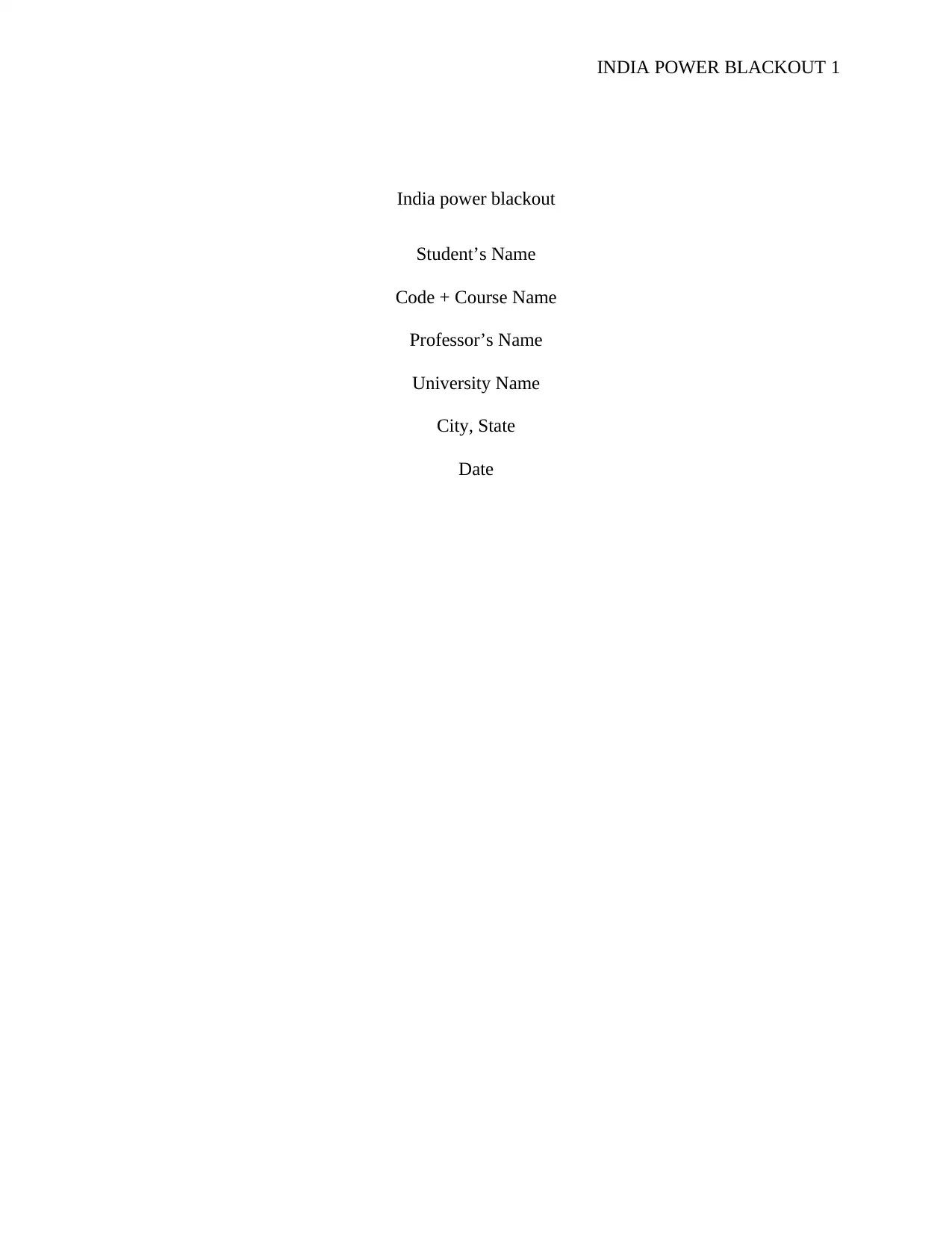
INDIA POWER BLACKOUT 1
India power blackout
Student’s Name
Code + Course Name
Professor’s Name
University Name
City, State
Date
India power blackout
Student’s Name
Code + Course Name
Professor’s Name
University Name
City, State
Date
Paraphrase This Document
Need a fresh take? Get an instant paraphrase of this document with our AI Paraphraser
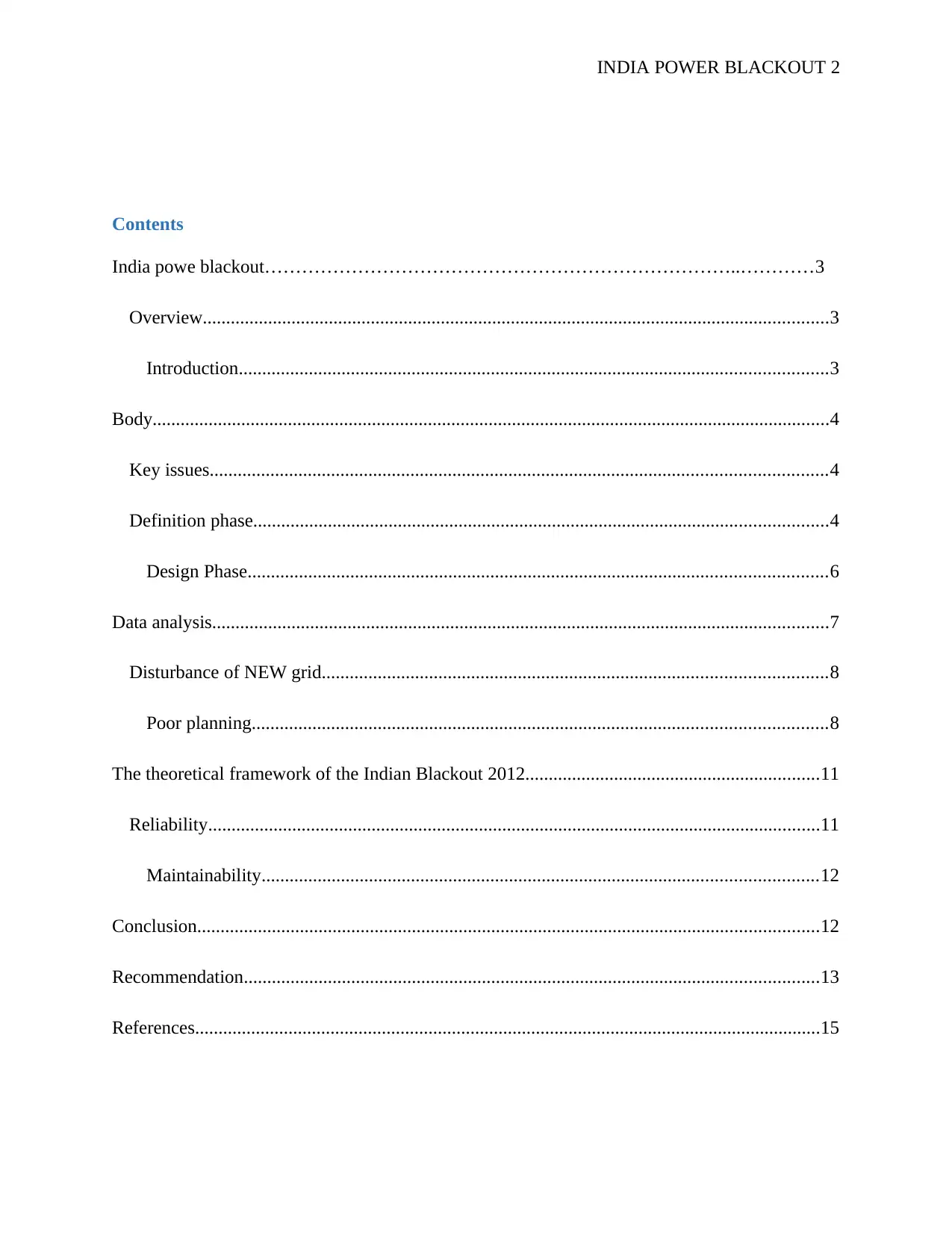
INDIA POWER BLACKOUT 2
Contents
India powe blackout…………………………………………………………………..…………3
Overview......................................................................................................................................3
Introduction..............................................................................................................................3
Body.................................................................................................................................................4
Key issues....................................................................................................................................4
Definition phase...........................................................................................................................4
Design Phase............................................................................................................................6
Data analysis....................................................................................................................................7
Disturbance of NEW grid............................................................................................................8
Poor planning...........................................................................................................................8
The theoretical framework of the Indian Blackout 2012...............................................................11
Reliability...................................................................................................................................11
Maintainability.......................................................................................................................12
Conclusion.....................................................................................................................................12
Recommendation...........................................................................................................................13
References......................................................................................................................................15
Contents
India powe blackout…………………………………………………………………..…………3
Overview......................................................................................................................................3
Introduction..............................................................................................................................3
Body.................................................................................................................................................4
Key issues....................................................................................................................................4
Definition phase...........................................................................................................................4
Design Phase............................................................................................................................6
Data analysis....................................................................................................................................7
Disturbance of NEW grid............................................................................................................8
Poor planning...........................................................................................................................8
The theoretical framework of the Indian Blackout 2012...............................................................11
Reliability...................................................................................................................................11
Maintainability.......................................................................................................................12
Conclusion.....................................................................................................................................12
Recommendation...........................................................................................................................13
References......................................................................................................................................15

INDIA POWER BLACKOUT 3
India power blackout
Overview
In the year 2012 India experienced a major power blackout which affected a vast
population. To date, it is described as the worst blackout in the world. What really caused the
blackout was a disturbance in the electricity grid. Basically, the electricity network in India is
divided into five grids, the eastern, western, north, north-eastern and south regional grid. The
northern national grid was disconnected from other grids giving rise to an outage. Later the
eastern, northern, northeastern grid collapsed. Most of the Indian states were left in darkness and
the power outage lasted a very long time as demonstrated by Liang and Chen (2013, p.8).
Situations that led to power blackout include hefty over-drawl by the states on the north and
oversupply by western states, improper management of the grid and little monitoring of the
power network. Major players in the Indian power sector were left in a blame game and later it
was found out that it could have been avoided.
Introduction
Asset management involves the process of developing, operating, upgrading and
disposing of asset is cost effective and also avoids major failures (Woodhouse, 2019, p.2). So it
is clear the process starts with the planning stage all the way to the operation of the asset. Asset
management has three major phases including definition, design and operating stage. In the
engineering context focused on two aspects of how the assets need to be managed. First, more
attention needs to be given to the information and communication technology required to
manage the data related to the asset. The second focus is on the management system and how
they can be integrated and managed to aid in decision making about the property. The main
India power blackout
Overview
In the year 2012 India experienced a major power blackout which affected a vast
population. To date, it is described as the worst blackout in the world. What really caused the
blackout was a disturbance in the electricity grid. Basically, the electricity network in India is
divided into five grids, the eastern, western, north, north-eastern and south regional grid. The
northern national grid was disconnected from other grids giving rise to an outage. Later the
eastern, northern, northeastern grid collapsed. Most of the Indian states were left in darkness and
the power outage lasted a very long time as demonstrated by Liang and Chen (2013, p.8).
Situations that led to power blackout include hefty over-drawl by the states on the north and
oversupply by western states, improper management of the grid and little monitoring of the
power network. Major players in the Indian power sector were left in a blame game and later it
was found out that it could have been avoided.
Introduction
Asset management involves the process of developing, operating, upgrading and
disposing of asset is cost effective and also avoids major failures (Woodhouse, 2019, p.2). So it
is clear the process starts with the planning stage all the way to the operation of the asset. Asset
management has three major phases including definition, design and operating stage. In the
engineering context focused on two aspects of how the assets need to be managed. First, more
attention needs to be given to the information and communication technology required to
manage the data related to the asset. The second focus is on the management system and how
they can be integrated and managed to aid in decision making about the property. The main
⊘ This is a preview!⊘
Do you want full access?
Subscribe today to unlock all pages.

Trusted by 1+ million students worldwide
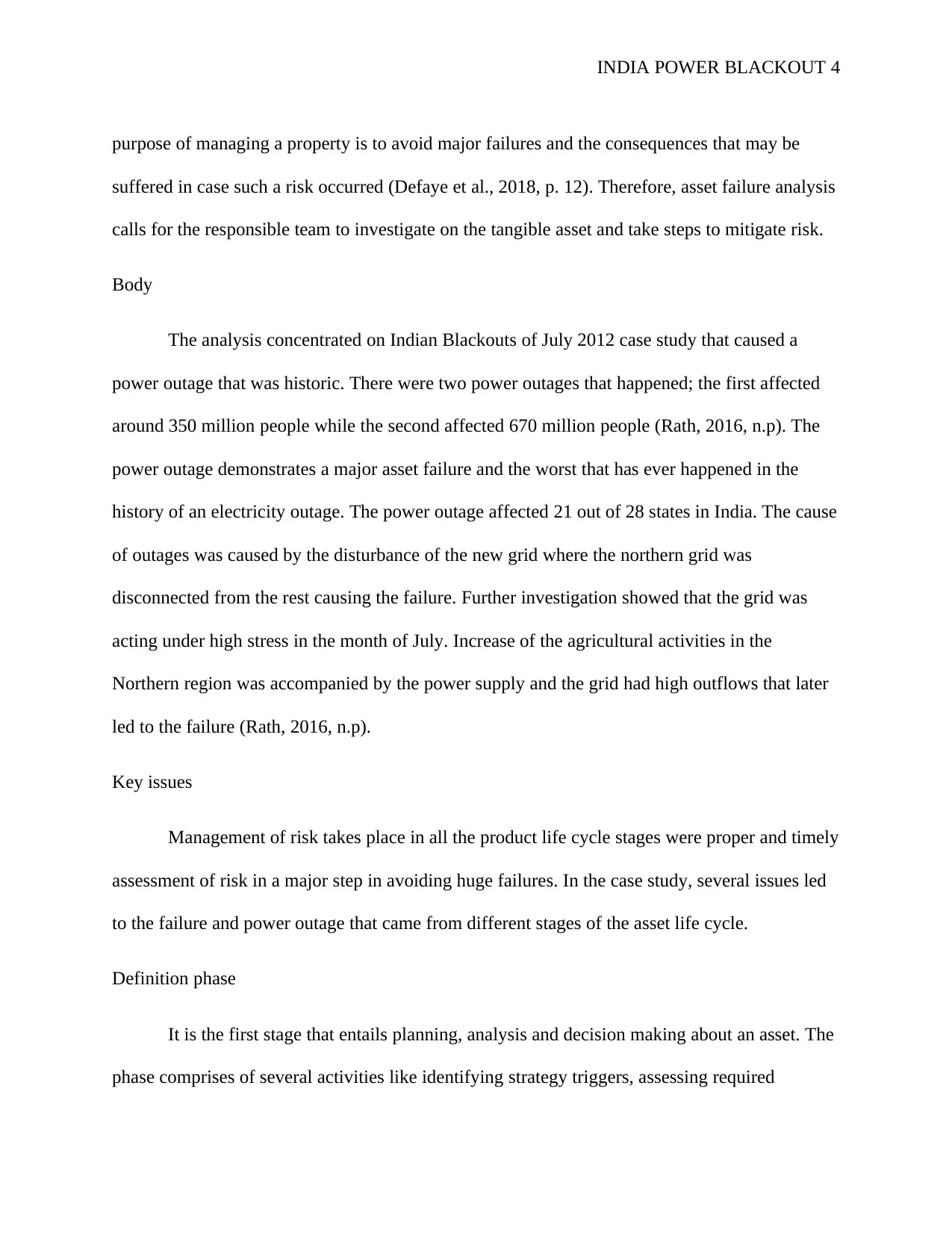
INDIA POWER BLACKOUT 4
purpose of managing a property is to avoid major failures and the consequences that may be
suffered in case such a risk occurred (Defaye et al., 2018, p. 12). Therefore, asset failure analysis
calls for the responsible team to investigate on the tangible asset and take steps to mitigate risk.
Body
The analysis concentrated on Indian Blackouts of July 2012 case study that caused a
power outage that was historic. There were two power outages that happened; the first affected
around 350 million people while the second affected 670 million people (Rath, 2016, n.p). The
power outage demonstrates a major asset failure and the worst that has ever happened in the
history of an electricity outage. The power outage affected 21 out of 28 states in India. The cause
of outages was caused by the disturbance of the new grid where the northern grid was
disconnected from the rest causing the failure. Further investigation showed that the grid was
acting under high stress in the month of July. Increase of the agricultural activities in the
Northern region was accompanied by the power supply and the grid had high outflows that later
led to the failure (Rath, 2016, n.p).
Key issues
Management of risk takes place in all the product life cycle stages were proper and timely
assessment of risk in a major step in avoiding huge failures. In the case study, several issues led
to the failure and power outage that came from different stages of the asset life cycle.
Definition phase
It is the first stage that entails planning, analysis and decision making about an asset. The
phase comprises of several activities like identifying strategy triggers, assessing required
purpose of managing a property is to avoid major failures and the consequences that may be
suffered in case such a risk occurred (Defaye et al., 2018, p. 12). Therefore, asset failure analysis
calls for the responsible team to investigate on the tangible asset and take steps to mitigate risk.
Body
The analysis concentrated on Indian Blackouts of July 2012 case study that caused a
power outage that was historic. There were two power outages that happened; the first affected
around 350 million people while the second affected 670 million people (Rath, 2016, n.p). The
power outage demonstrates a major asset failure and the worst that has ever happened in the
history of an electricity outage. The power outage affected 21 out of 28 states in India. The cause
of outages was caused by the disturbance of the new grid where the northern grid was
disconnected from the rest causing the failure. Further investigation showed that the grid was
acting under high stress in the month of July. Increase of the agricultural activities in the
Northern region was accompanied by the power supply and the grid had high outflows that later
led to the failure (Rath, 2016, n.p).
Key issues
Management of risk takes place in all the product life cycle stages were proper and timely
assessment of risk in a major step in avoiding huge failures. In the case study, several issues led
to the failure and power outage that came from different stages of the asset life cycle.
Definition phase
It is the first stage that entails planning, analysis and decision making about an asset. The
phase comprises of several activities like identifying strategy triggers, assessing required
Paraphrase This Document
Need a fresh take? Get an instant paraphrase of this document with our AI Paraphraser
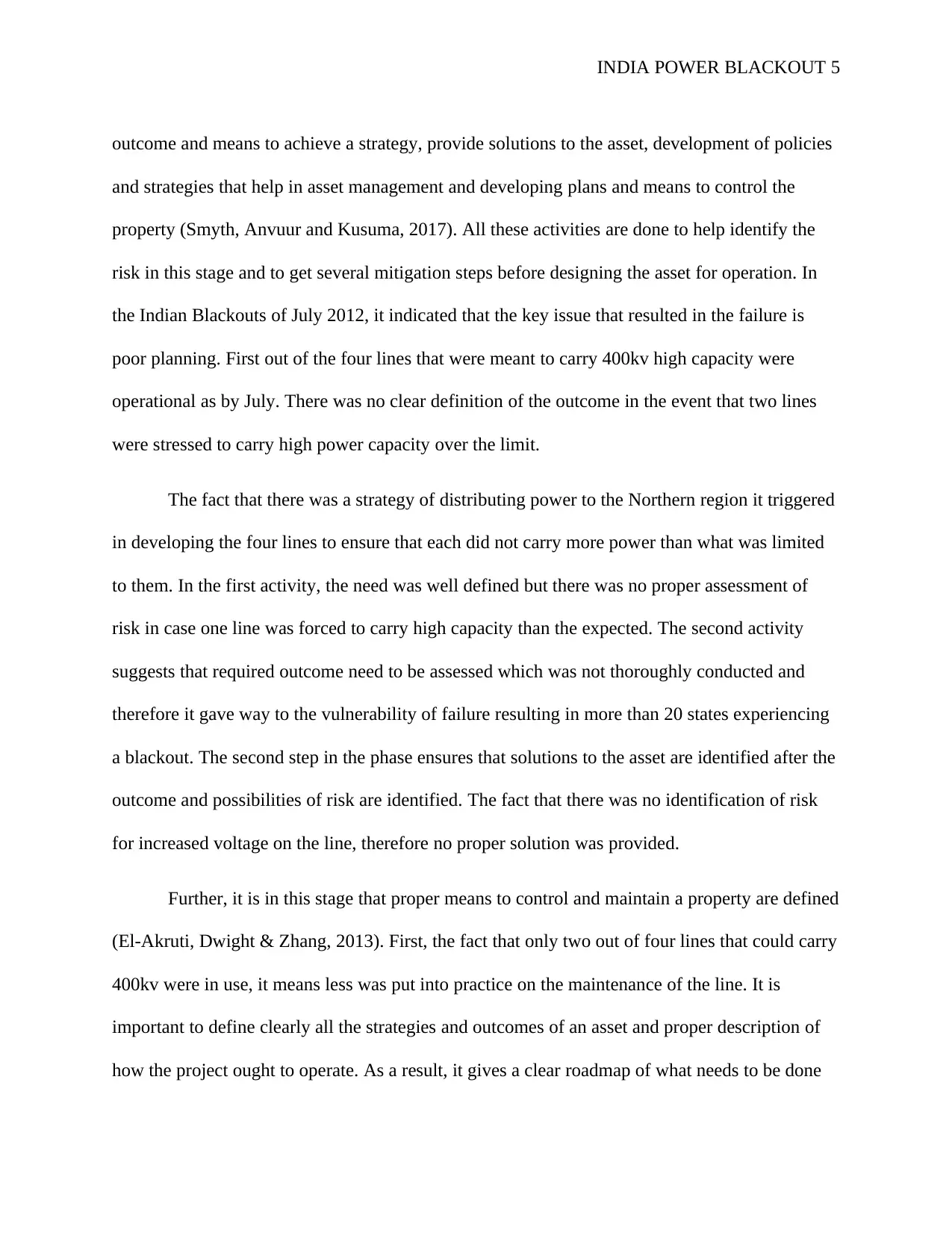
INDIA POWER BLACKOUT 5
outcome and means to achieve a strategy, provide solutions to the asset, development of policies
and strategies that help in asset management and developing plans and means to control the
property (Smyth, Anvuur and Kusuma, 2017). All these activities are done to help identify the
risk in this stage and to get several mitigation steps before designing the asset for operation. In
the Indian Blackouts of July 2012, it indicated that the key issue that resulted in the failure is
poor planning. First out of the four lines that were meant to carry 400kv high capacity were
operational as by July. There was no clear definition of the outcome in the event that two lines
were stressed to carry high power capacity over the limit.
The fact that there was a strategy of distributing power to the Northern region it triggered
in developing the four lines to ensure that each did not carry more power than what was limited
to them. In the first activity, the need was well defined but there was no proper assessment of
risk in case one line was forced to carry high capacity than the expected. The second activity
suggests that required outcome need to be assessed which was not thoroughly conducted and
therefore it gave way to the vulnerability of failure resulting in more than 20 states experiencing
a blackout. The second step in the phase ensures that solutions to the asset are identified after the
outcome and possibilities of risk are identified. The fact that there was no identification of risk
for increased voltage on the line, therefore no proper solution was provided.
Further, it is in this stage that proper means to control and maintain a property are defined
(El-Akruti, Dwight & Zhang, 2013). First, the fact that only two out of four lines that could carry
400kv were in use, it means less was put into practice on the maintenance of the line. It is
important to define clearly all the strategies and outcomes of an asset and proper description of
how the project ought to operate. As a result, it gives a clear roadmap of what needs to be done
outcome and means to achieve a strategy, provide solutions to the asset, development of policies
and strategies that help in asset management and developing plans and means to control the
property (Smyth, Anvuur and Kusuma, 2017). All these activities are done to help identify the
risk in this stage and to get several mitigation steps before designing the asset for operation. In
the Indian Blackouts of July 2012, it indicated that the key issue that resulted in the failure is
poor planning. First out of the four lines that were meant to carry 400kv high capacity were
operational as by July. There was no clear definition of the outcome in the event that two lines
were stressed to carry high power capacity over the limit.
The fact that there was a strategy of distributing power to the Northern region it triggered
in developing the four lines to ensure that each did not carry more power than what was limited
to them. In the first activity, the need was well defined but there was no proper assessment of
risk in case one line was forced to carry high capacity than the expected. The second activity
suggests that required outcome need to be assessed which was not thoroughly conducted and
therefore it gave way to the vulnerability of failure resulting in more than 20 states experiencing
a blackout. The second step in the phase ensures that solutions to the asset are identified after the
outcome and possibilities of risk are identified. The fact that there was no identification of risk
for increased voltage on the line, therefore no proper solution was provided.
Further, it is in this stage that proper means to control and maintain a property are defined
(El-Akruti, Dwight & Zhang, 2013). First, the fact that only two out of four lines that could carry
400kv were in use, it means less was put into practice on the maintenance of the line. It is
important to define clearly all the strategies and outcomes of an asset and proper description of
how the project ought to operate. As a result, it gives a clear roadmap of what needs to be done
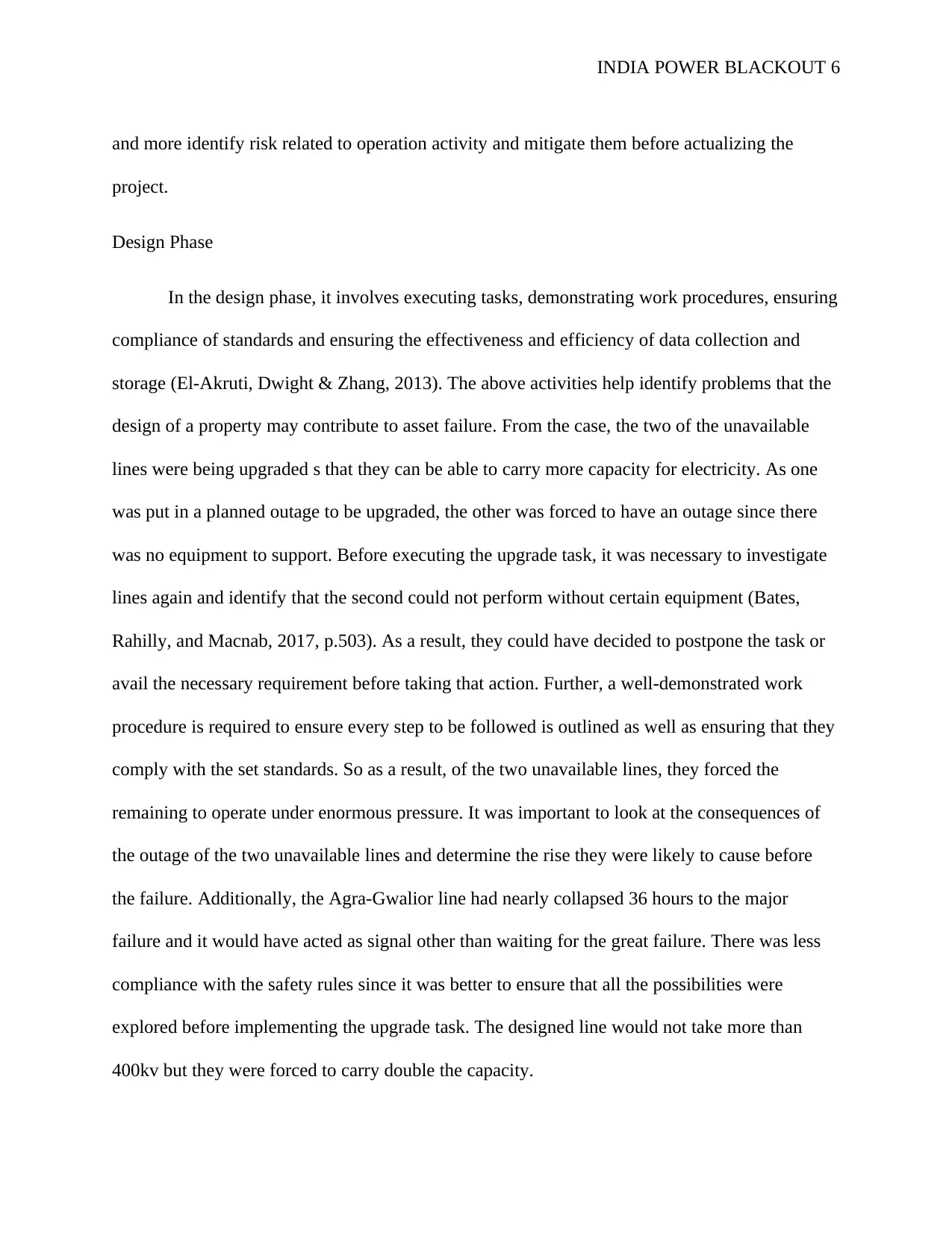
INDIA POWER BLACKOUT 6
and more identify risk related to operation activity and mitigate them before actualizing the
project.
Design Phase
In the design phase, it involves executing tasks, demonstrating work procedures, ensuring
compliance of standards and ensuring the effectiveness and efficiency of data collection and
storage (El-Akruti, Dwight & Zhang, 2013). The above activities help identify problems that the
design of a property may contribute to asset failure. From the case, the two of the unavailable
lines were being upgraded s that they can be able to carry more capacity for electricity. As one
was put in a planned outage to be upgraded, the other was forced to have an outage since there
was no equipment to support. Before executing the upgrade task, it was necessary to investigate
lines again and identify that the second could not perform without certain equipment (Bates,
Rahilly, and Macnab, 2017, p.503). As a result, they could have decided to postpone the task or
avail the necessary requirement before taking that action. Further, a well-demonstrated work
procedure is required to ensure every step to be followed is outlined as well as ensuring that they
comply with the set standards. So as a result, of the two unavailable lines, they forced the
remaining to operate under enormous pressure. It was important to look at the consequences of
the outage of the two unavailable lines and determine the rise they were likely to cause before
the failure. Additionally, the Agra-Gwalior line had nearly collapsed 36 hours to the major
failure and it would have acted as signal other than waiting for the great failure. There was less
compliance with the safety rules since it was better to ensure that all the possibilities were
explored before implementing the upgrade task. The designed line would not take more than
400kv but they were forced to carry double the capacity.
and more identify risk related to operation activity and mitigate them before actualizing the
project.
Design Phase
In the design phase, it involves executing tasks, demonstrating work procedures, ensuring
compliance of standards and ensuring the effectiveness and efficiency of data collection and
storage (El-Akruti, Dwight & Zhang, 2013). The above activities help identify problems that the
design of a property may contribute to asset failure. From the case, the two of the unavailable
lines were being upgraded s that they can be able to carry more capacity for electricity. As one
was put in a planned outage to be upgraded, the other was forced to have an outage since there
was no equipment to support. Before executing the upgrade task, it was necessary to investigate
lines again and identify that the second could not perform without certain equipment (Bates,
Rahilly, and Macnab, 2017, p.503). As a result, they could have decided to postpone the task or
avail the necessary requirement before taking that action. Further, a well-demonstrated work
procedure is required to ensure every step to be followed is outlined as well as ensuring that they
comply with the set standards. So as a result, of the two unavailable lines, they forced the
remaining to operate under enormous pressure. It was important to look at the consequences of
the outage of the two unavailable lines and determine the rise they were likely to cause before
the failure. Additionally, the Agra-Gwalior line had nearly collapsed 36 hours to the major
failure and it would have acted as signal other than waiting for the great failure. There was less
compliance with the safety rules since it was better to ensure that all the possibilities were
explored before implementing the upgrade task. The designed line would not take more than
400kv but they were forced to carry double the capacity.
⊘ This is a preview!⊘
Do you want full access?
Subscribe today to unlock all pages.

Trusted by 1+ million students worldwide
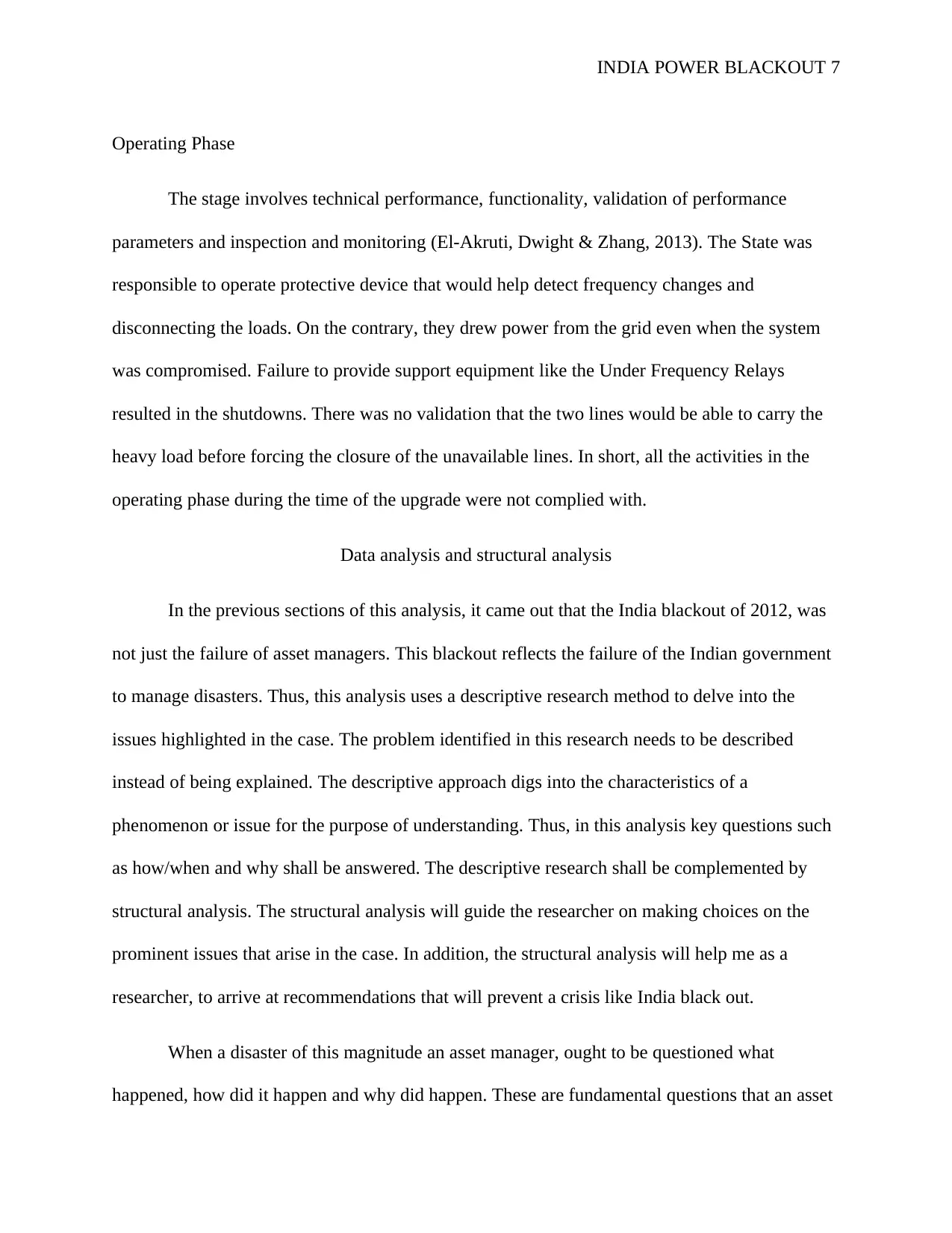
INDIA POWER BLACKOUT 7
Operating Phase
The stage involves technical performance, functionality, validation of performance
parameters and inspection and monitoring (El-Akruti, Dwight & Zhang, 2013). The State was
responsible to operate protective device that would help detect frequency changes and
disconnecting the loads. On the contrary, they drew power from the grid even when the system
was compromised. Failure to provide support equipment like the Under Frequency Relays
resulted in the shutdowns. There was no validation that the two lines would be able to carry the
heavy load before forcing the closure of the unavailable lines. In short, all the activities in the
operating phase during the time of the upgrade were not complied with.
Data analysis and structural analysis
In the previous sections of this analysis, it came out that the India blackout of 2012, was
not just the failure of asset managers. This blackout reflects the failure of the Indian government
to manage disasters. Thus, this analysis uses a descriptive research method to delve into the
issues highlighted in the case. The problem identified in this research needs to be described
instead of being explained. The descriptive approach digs into the characteristics of a
phenomenon or issue for the purpose of understanding. Thus, in this analysis key questions such
as how/when and why shall be answered. The descriptive research shall be complemented by
structural analysis. The structural analysis will guide the researcher on making choices on the
prominent issues that arise in the case. In addition, the structural analysis will help me as a
researcher, to arrive at recommendations that will prevent a crisis like India black out.
When a disaster of this magnitude an asset manager, ought to be questioned what
happened, how did it happen and why did happen. These are fundamental questions that an asset
Operating Phase
The stage involves technical performance, functionality, validation of performance
parameters and inspection and monitoring (El-Akruti, Dwight & Zhang, 2013). The State was
responsible to operate protective device that would help detect frequency changes and
disconnecting the loads. On the contrary, they drew power from the grid even when the system
was compromised. Failure to provide support equipment like the Under Frequency Relays
resulted in the shutdowns. There was no validation that the two lines would be able to carry the
heavy load before forcing the closure of the unavailable lines. In short, all the activities in the
operating phase during the time of the upgrade were not complied with.
Data analysis and structural analysis
In the previous sections of this analysis, it came out that the India blackout of 2012, was
not just the failure of asset managers. This blackout reflects the failure of the Indian government
to manage disasters. Thus, this analysis uses a descriptive research method to delve into the
issues highlighted in the case. The problem identified in this research needs to be described
instead of being explained. The descriptive approach digs into the characteristics of a
phenomenon or issue for the purpose of understanding. Thus, in this analysis key questions such
as how/when and why shall be answered. The descriptive research shall be complemented by
structural analysis. The structural analysis will guide the researcher on making choices on the
prominent issues that arise in the case. In addition, the structural analysis will help me as a
researcher, to arrive at recommendations that will prevent a crisis like India black out.
When a disaster of this magnitude an asset manager, ought to be questioned what
happened, how did it happen and why did happen. These are fundamental questions that an asset
Paraphrase This Document
Need a fresh take? Get an instant paraphrase of this document with our AI Paraphraser
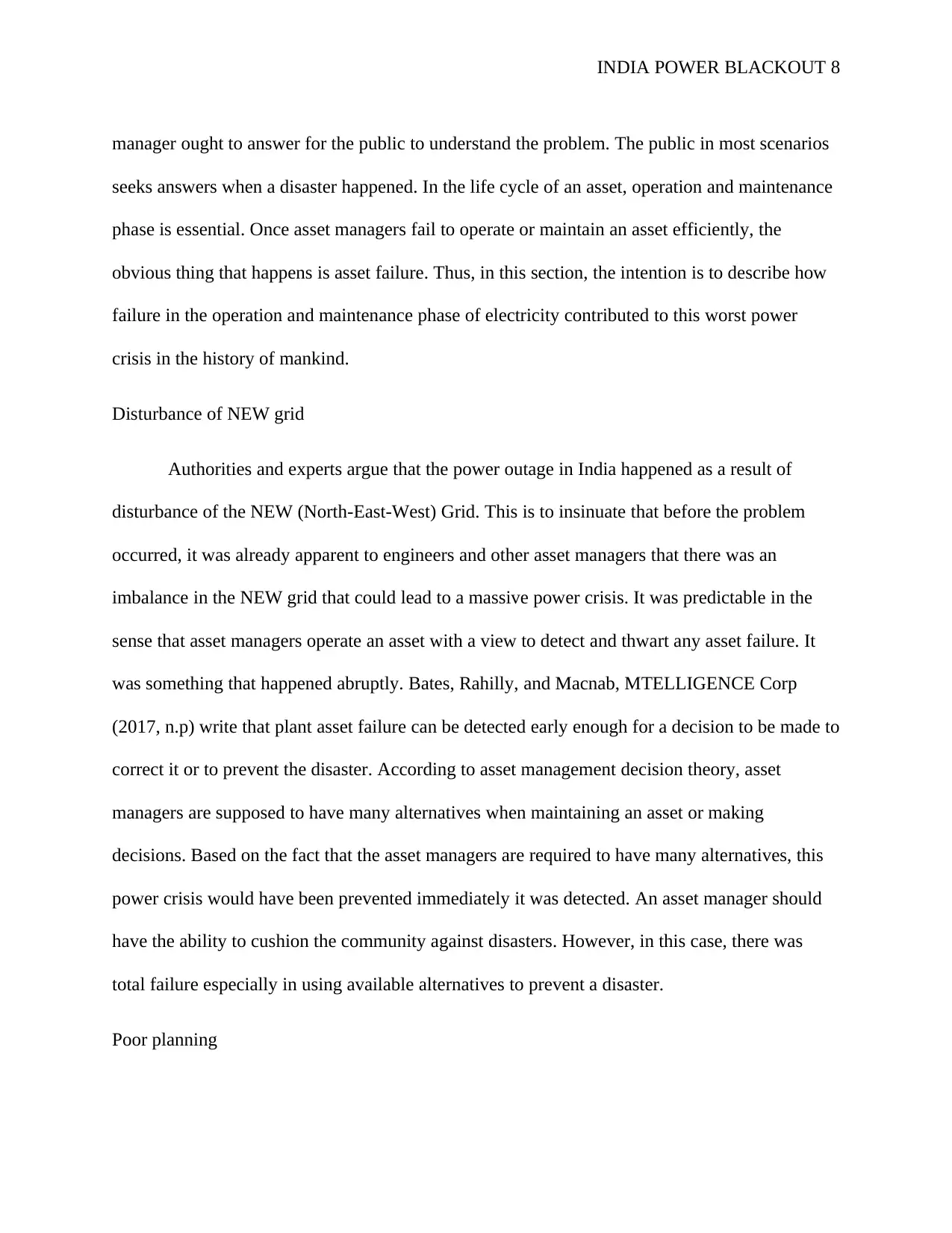
INDIA POWER BLACKOUT 8
manager ought to answer for the public to understand the problem. The public in most scenarios
seeks answers when a disaster happened. In the life cycle of an asset, operation and maintenance
phase is essential. Once asset managers fail to operate or maintain an asset efficiently, the
obvious thing that happens is asset failure. Thus, in this section, the intention is to describe how
failure in the operation and maintenance phase of electricity contributed to this worst power
crisis in the history of mankind.
Disturbance of NEW grid
Authorities and experts argue that the power outage in India happened as a result of
disturbance of the NEW (North-East-West) Grid. This is to insinuate that before the problem
occurred, it was already apparent to engineers and other asset managers that there was an
imbalance in the NEW grid that could lead to a massive power crisis. It was predictable in the
sense that asset managers operate an asset with a view to detect and thwart any asset failure. It
was something that happened abruptly. Bates, Rahilly, and Macnab, MTELLIGENCE Corp
(2017, n.p) write that plant asset failure can be detected early enough for a decision to be made to
correct it or to prevent the disaster. According to asset management decision theory, asset
managers are supposed to have many alternatives when maintaining an asset or making
decisions. Based on the fact that the asset managers are required to have many alternatives, this
power crisis would have been prevented immediately it was detected. An asset manager should
have the ability to cushion the community against disasters. However, in this case, there was
total failure especially in using available alternatives to prevent a disaster.
Poor planning
manager ought to answer for the public to understand the problem. The public in most scenarios
seeks answers when a disaster happened. In the life cycle of an asset, operation and maintenance
phase is essential. Once asset managers fail to operate or maintain an asset efficiently, the
obvious thing that happens is asset failure. Thus, in this section, the intention is to describe how
failure in the operation and maintenance phase of electricity contributed to this worst power
crisis in the history of mankind.
Disturbance of NEW grid
Authorities and experts argue that the power outage in India happened as a result of
disturbance of the NEW (North-East-West) Grid. This is to insinuate that before the problem
occurred, it was already apparent to engineers and other asset managers that there was an
imbalance in the NEW grid that could lead to a massive power crisis. It was predictable in the
sense that asset managers operate an asset with a view to detect and thwart any asset failure. It
was something that happened abruptly. Bates, Rahilly, and Macnab, MTELLIGENCE Corp
(2017, n.p) write that plant asset failure can be detected early enough for a decision to be made to
correct it or to prevent the disaster. According to asset management decision theory, asset
managers are supposed to have many alternatives when maintaining an asset or making
decisions. Based on the fact that the asset managers are required to have many alternatives, this
power crisis would have been prevented immediately it was detected. An asset manager should
have the ability to cushion the community against disasters. However, in this case, there was
total failure especially in using available alternatives to prevent a disaster.
Poor planning
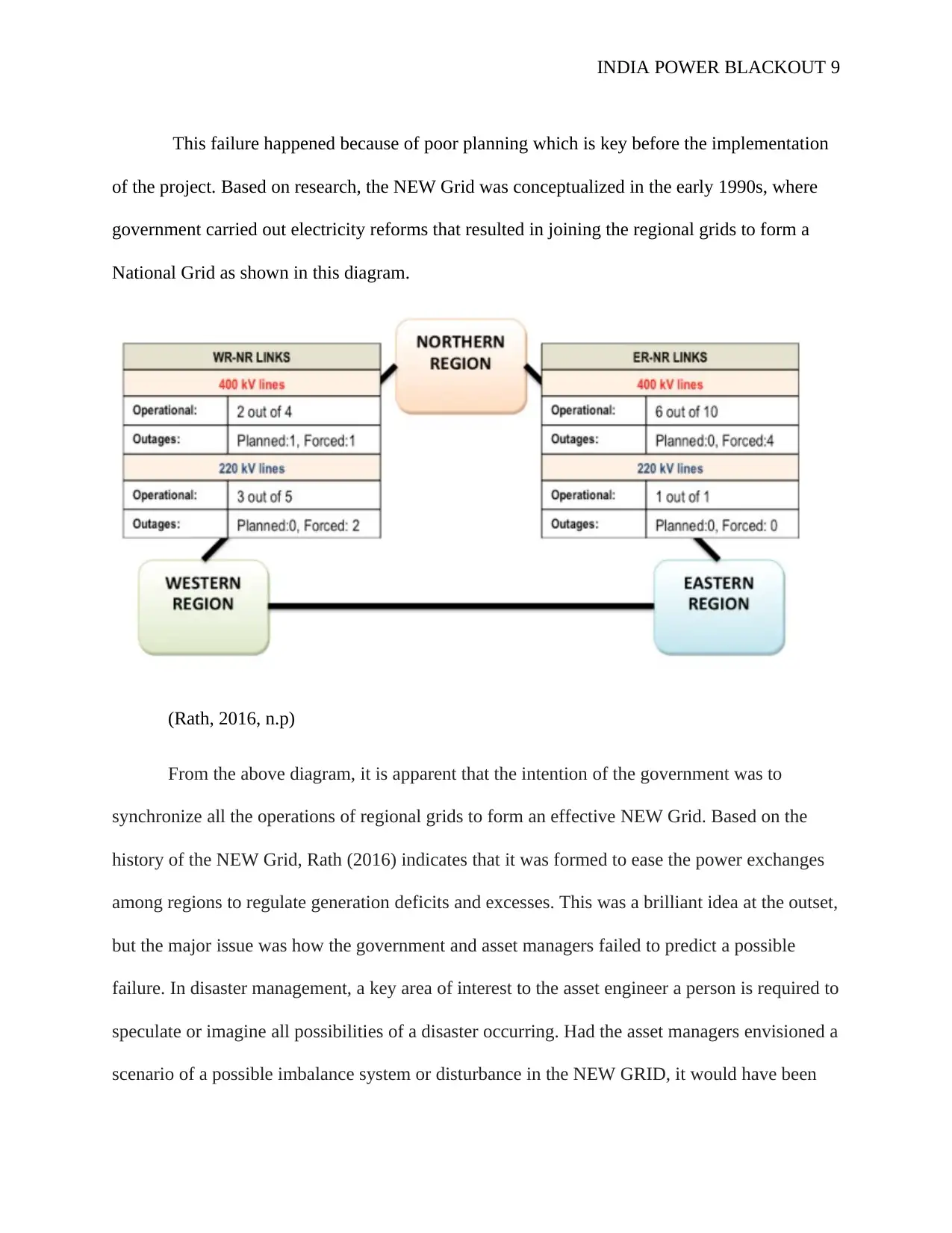
INDIA POWER BLACKOUT 9
This failure happened because of poor planning which is key before the implementation
of the project. Based on research, the NEW Grid was conceptualized in the early 1990s, where
government carried out electricity reforms that resulted in joining the regional grids to form a
National Grid as shown in this diagram.
(Rath, 2016, n.p)
From the above diagram, it is apparent that the intention of the government was to
synchronize all the operations of regional grids to form an effective NEW Grid. Based on the
history of the NEW Grid, Rath (2016) indicates that it was formed to ease the power exchanges
among regions to regulate generation deficits and excesses. This was a brilliant idea at the outset,
but the major issue was how the government and asset managers failed to predict a possible
failure. In disaster management, a key area of interest to the asset engineer a person is required to
speculate or imagine all possibilities of a disaster occurring. Had the asset managers envisioned a
scenario of a possible imbalance system or disturbance in the NEW GRID, it would have been
This failure happened because of poor planning which is key before the implementation
of the project. Based on research, the NEW Grid was conceptualized in the early 1990s, where
government carried out electricity reforms that resulted in joining the regional grids to form a
National Grid as shown in this diagram.
(Rath, 2016, n.p)
From the above diagram, it is apparent that the intention of the government was to
synchronize all the operations of regional grids to form an effective NEW Grid. Based on the
history of the NEW Grid, Rath (2016) indicates that it was formed to ease the power exchanges
among regions to regulate generation deficits and excesses. This was a brilliant idea at the outset,
but the major issue was how the government and asset managers failed to predict a possible
failure. In disaster management, a key area of interest to the asset engineer a person is required to
speculate or imagine all possibilities of a disaster occurring. Had the asset managers envisioned a
scenario of a possible imbalance system or disturbance in the NEW GRID, it would have been
⊘ This is a preview!⊘
Do you want full access?
Subscribe today to unlock all pages.

Trusted by 1+ million students worldwide
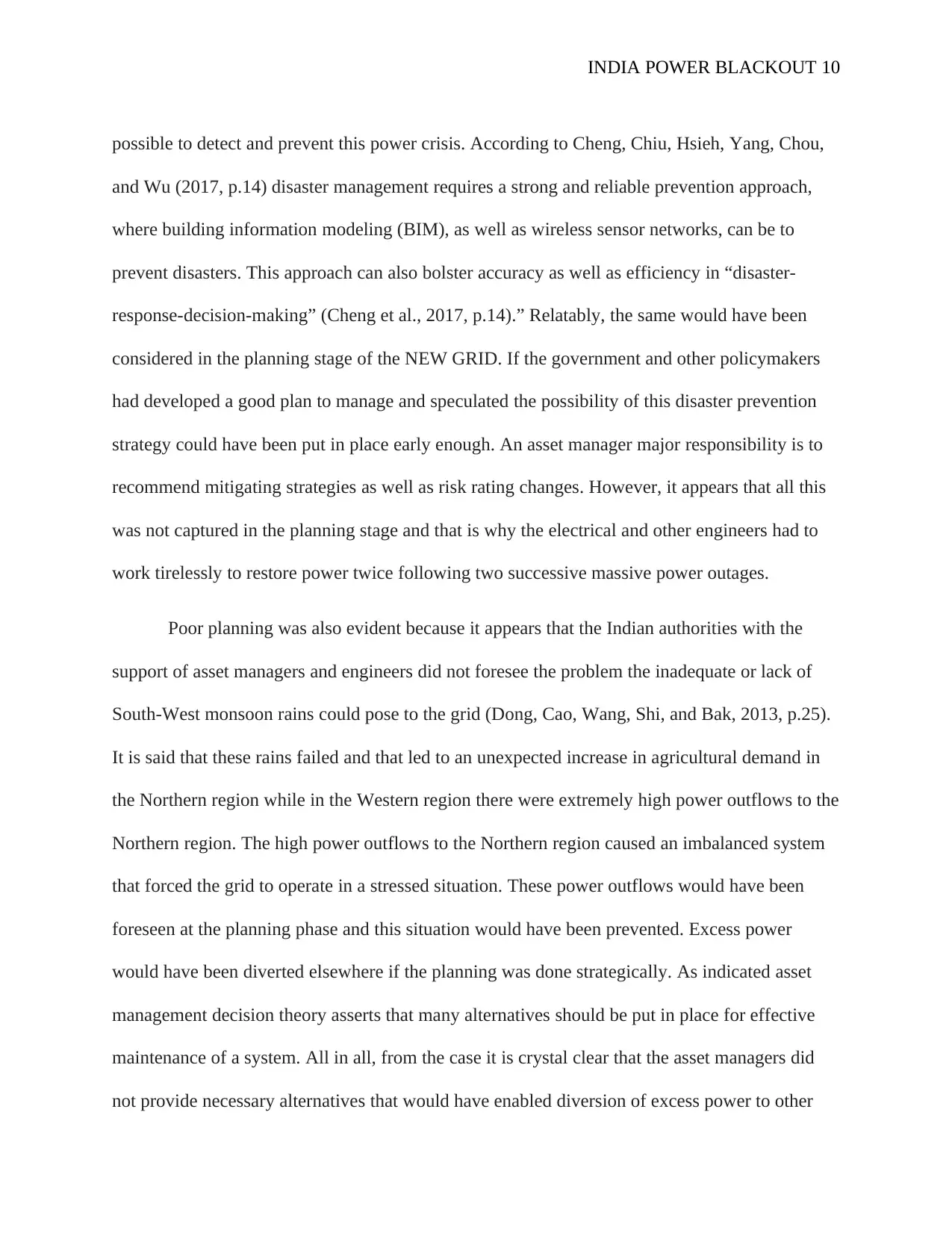
INDIA POWER BLACKOUT 10
possible to detect and prevent this power crisis. According to Cheng, Chiu, Hsieh, Yang, Chou,
and Wu (2017, p.14) disaster management requires a strong and reliable prevention approach,
where building information modeling (BIM), as well as wireless sensor networks, can be to
prevent disasters. This approach can also bolster accuracy as well as efficiency in “disaster-
response-decision-making” (Cheng et al., 2017, p.14).” Relatably, the same would have been
considered in the planning stage of the NEW GRID. If the government and other policymakers
had developed a good plan to manage and speculated the possibility of this disaster prevention
strategy could have been put in place early enough. An asset manager major responsibility is to
recommend mitigating strategies as well as risk rating changes. However, it appears that all this
was not captured in the planning stage and that is why the electrical and other engineers had to
work tirelessly to restore power twice following two successive massive power outages.
Poor planning was also evident because it appears that the Indian authorities with the
support of asset managers and engineers did not foresee the problem the inadequate or lack of
South-West monsoon rains could pose to the grid (Dong, Cao, Wang, Shi, and Bak, 2013, p.25).
It is said that these rains failed and that led to an unexpected increase in agricultural demand in
the Northern region while in the Western region there were extremely high power outflows to the
Northern region. The high power outflows to the Northern region caused an imbalanced system
that forced the grid to operate in a stressed situation. These power outflows would have been
foreseen at the planning phase and this situation would have been prevented. Excess power
would have been diverted elsewhere if the planning was done strategically. As indicated asset
management decision theory asserts that many alternatives should be put in place for effective
maintenance of a system. All in all, from the case it is crystal clear that the asset managers did
not provide necessary alternatives that would have enabled diversion of excess power to other
possible to detect and prevent this power crisis. According to Cheng, Chiu, Hsieh, Yang, Chou,
and Wu (2017, p.14) disaster management requires a strong and reliable prevention approach,
where building information modeling (BIM), as well as wireless sensor networks, can be to
prevent disasters. This approach can also bolster accuracy as well as efficiency in “disaster-
response-decision-making” (Cheng et al., 2017, p.14).” Relatably, the same would have been
considered in the planning stage of the NEW GRID. If the government and other policymakers
had developed a good plan to manage and speculated the possibility of this disaster prevention
strategy could have been put in place early enough. An asset manager major responsibility is to
recommend mitigating strategies as well as risk rating changes. However, it appears that all this
was not captured in the planning stage and that is why the electrical and other engineers had to
work tirelessly to restore power twice following two successive massive power outages.
Poor planning was also evident because it appears that the Indian authorities with the
support of asset managers and engineers did not foresee the problem the inadequate or lack of
South-West monsoon rains could pose to the grid (Dong, Cao, Wang, Shi, and Bak, 2013, p.25).
It is said that these rains failed and that led to an unexpected increase in agricultural demand in
the Northern region while in the Western region there were extremely high power outflows to the
Northern region. The high power outflows to the Northern region caused an imbalanced system
that forced the grid to operate in a stressed situation. These power outflows would have been
foreseen at the planning phase and this situation would have been prevented. Excess power
would have been diverted elsewhere if the planning was done strategically. As indicated asset
management decision theory asserts that many alternatives should be put in place for effective
maintenance of a system. All in all, from the case it is crystal clear that the asset managers did
not provide necessary alternatives that would have enabled diversion of excess power to other
Paraphrase This Document
Need a fresh take? Get an instant paraphrase of this document with our AI Paraphraser
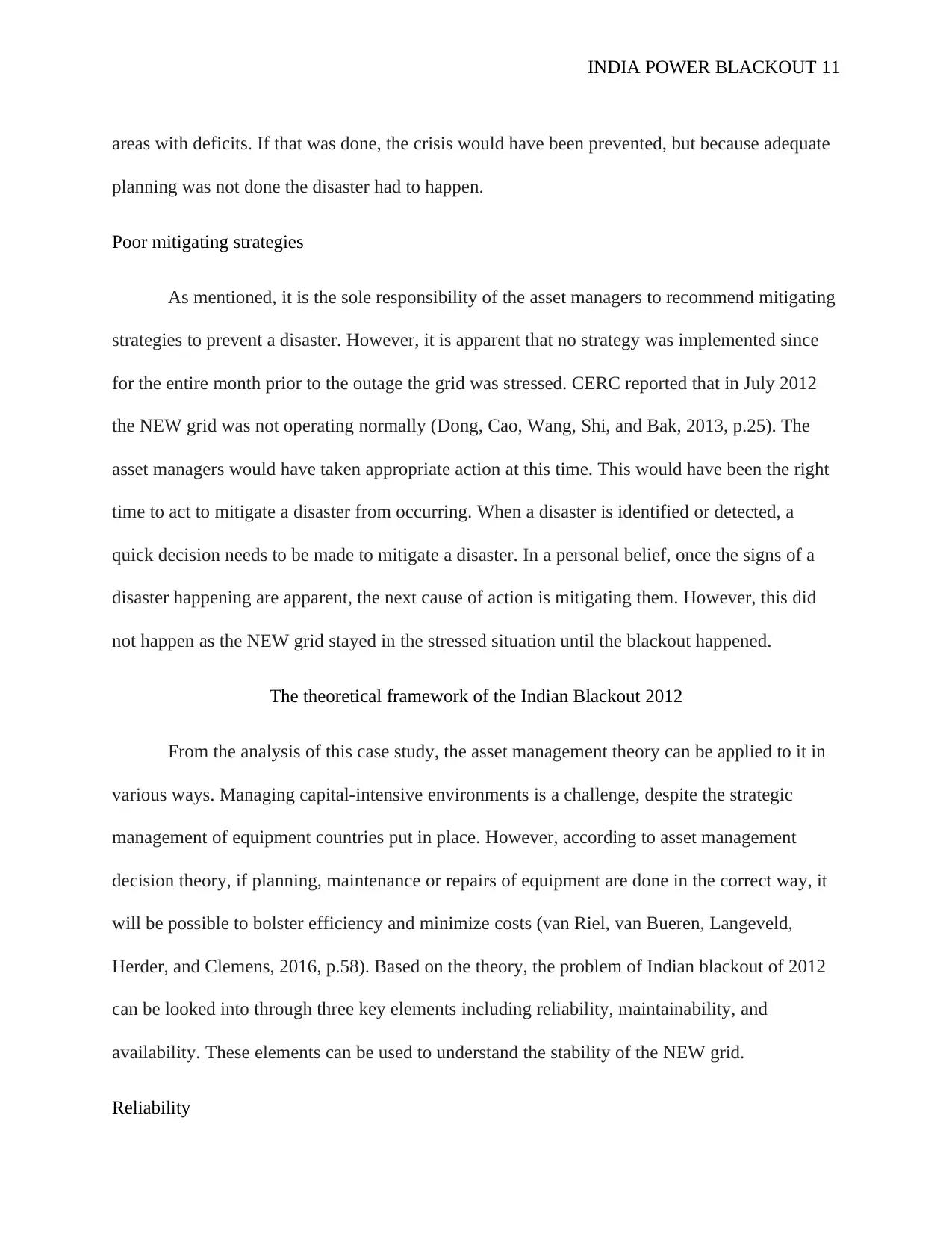
INDIA POWER BLACKOUT 11
areas with deficits. If that was done, the crisis would have been prevented, but because adequate
planning was not done the disaster had to happen.
Poor mitigating strategies
As mentioned, it is the sole responsibility of the asset managers to recommend mitigating
strategies to prevent a disaster. However, it is apparent that no strategy was implemented since
for the entire month prior to the outage the grid was stressed. CERC reported that in July 2012
the NEW grid was not operating normally (Dong, Cao, Wang, Shi, and Bak, 2013, p.25). The
asset managers would have taken appropriate action at this time. This would have been the right
time to act to mitigate a disaster from occurring. When a disaster is identified or detected, a
quick decision needs to be made to mitigate a disaster. In a personal belief, once the signs of a
disaster happening are apparent, the next cause of action is mitigating them. However, this did
not happen as the NEW grid stayed in the stressed situation until the blackout happened.
The theoretical framework of the Indian Blackout 2012
From the analysis of this case study, the asset management theory can be applied to it in
various ways. Managing capital-intensive environments is a challenge, despite the strategic
management of equipment countries put in place. However, according to asset management
decision theory, if planning, maintenance or repairs of equipment are done in the correct way, it
will be possible to bolster efficiency and minimize costs (van Riel, van Bueren, Langeveld,
Herder, and Clemens, 2016, p.58). Based on the theory, the problem of Indian blackout of 2012
can be looked into through three key elements including reliability, maintainability, and
availability. These elements can be used to understand the stability of the NEW grid.
Reliability
areas with deficits. If that was done, the crisis would have been prevented, but because adequate
planning was not done the disaster had to happen.
Poor mitigating strategies
As mentioned, it is the sole responsibility of the asset managers to recommend mitigating
strategies to prevent a disaster. However, it is apparent that no strategy was implemented since
for the entire month prior to the outage the grid was stressed. CERC reported that in July 2012
the NEW grid was not operating normally (Dong, Cao, Wang, Shi, and Bak, 2013, p.25). The
asset managers would have taken appropriate action at this time. This would have been the right
time to act to mitigate a disaster from occurring. When a disaster is identified or detected, a
quick decision needs to be made to mitigate a disaster. In a personal belief, once the signs of a
disaster happening are apparent, the next cause of action is mitigating them. However, this did
not happen as the NEW grid stayed in the stressed situation until the blackout happened.
The theoretical framework of the Indian Blackout 2012
From the analysis of this case study, the asset management theory can be applied to it in
various ways. Managing capital-intensive environments is a challenge, despite the strategic
management of equipment countries put in place. However, according to asset management
decision theory, if planning, maintenance or repairs of equipment are done in the correct way, it
will be possible to bolster efficiency and minimize costs (van Riel, van Bueren, Langeveld,
Herder, and Clemens, 2016, p.58). Based on the theory, the problem of Indian blackout of 2012
can be looked into through three key elements including reliability, maintainability, and
availability. These elements can be used to understand the stability of the NEW grid.
Reliability

INDIA POWER BLACKOUT 12
The New grid came into existence following a wave of electricity reforms in India in the
1990s. It was until 2012 that this crisis happened. This reveals that for a long time the asset
managers had managed to stabilize the electricity asset. In this regard, it is reasonable to applaud
the asset managers for making this grid reliable for such a long time. However, the asset
managers need to look forward and see how the crisis can be prevented in the future to guarantee
reliability.
Maintainability
Clearly, there was an attempt to maintain this grid, and therefore this failure cannot be in
wholesomeness be blamed on the asset managers. Asset managers work effectively if their
decisions and recommendations are followed for the asset to remain stable. Due to that, the
Indian authority cannot evade the blame for failing to give funding that would have hastened the
upgrade of the NEW grid to prevent crises.
Availability
The NEW grid is still reliable and able to supply power to millions of Indians who rely
on it. The utility of asset is realized once its availability is guaranteed and due to that that asset
managers shall have to work indefatigably to ensure the power supply from this grid is
guaranteed.
Conclusion
In regard to the 2012 power crisis in India, there are critical points that an asset manager
should take to prevent such from happening. The major point is the maintenance of an asset.
Once an asset is operational, there is a tendency of people not maintaining it as expected and this
The New grid came into existence following a wave of electricity reforms in India in the
1990s. It was until 2012 that this crisis happened. This reveals that for a long time the asset
managers had managed to stabilize the electricity asset. In this regard, it is reasonable to applaud
the asset managers for making this grid reliable for such a long time. However, the asset
managers need to look forward and see how the crisis can be prevented in the future to guarantee
reliability.
Maintainability
Clearly, there was an attempt to maintain this grid, and therefore this failure cannot be in
wholesomeness be blamed on the asset managers. Asset managers work effectively if their
decisions and recommendations are followed for the asset to remain stable. Due to that, the
Indian authority cannot evade the blame for failing to give funding that would have hastened the
upgrade of the NEW grid to prevent crises.
Availability
The NEW grid is still reliable and able to supply power to millions of Indians who rely
on it. The utility of asset is realized once its availability is guaranteed and due to that that asset
managers shall have to work indefatigably to ensure the power supply from this grid is
guaranteed.
Conclusion
In regard to the 2012 power crisis in India, there are critical points that an asset manager
should take to prevent such from happening. The major point is the maintenance of an asset.
Once an asset is operational, there is a tendency of people not maintaining it as expected and this
⊘ This is a preview!⊘
Do you want full access?
Subscribe today to unlock all pages.

Trusted by 1+ million students worldwide
1 out of 17
Related Documents
Your All-in-One AI-Powered Toolkit for Academic Success.
+13062052269
info@desklib.com
Available 24*7 on WhatsApp / Email
![[object Object]](/_next/static/media/star-bottom.7253800d.svg)
Unlock your academic potential
Copyright © 2020–2025 A2Z Services. All Rights Reserved. Developed and managed by ZUCOL.

